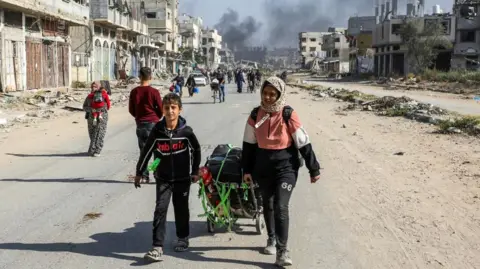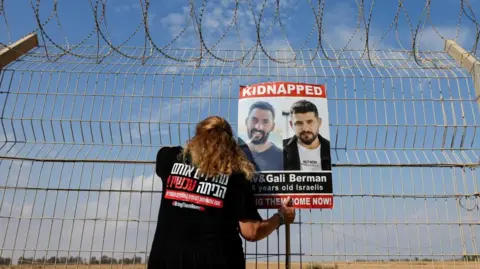
 Reuters
ReutersIt is believed that Israel and Hamas are close to reaching an agreement that could stop the war in Gaza and see the release of Israeli hostages and Palestinian prisoners.
It would be the most dramatic breakthrough in 15 months of war, which began when the Palestinian militant group Hamas attacked Israel in October 2023.
What could the ceasefire agreement between Israel and Hamas include?
It is hoped that the ceasefire agreement will mean an agreement to stop the ongoing war in Gaza.
It is also expected to witness an exchange of hostages and prisoners.
Hamas took 251 hostages when it attacked Israel in October 2023. It still holds 94 hostage, although Israel believes only 60 are still alive.
Israel is expected to release about a thousand Palestinian prisoners, some of whom have been imprisoned for years, in exchange for the release of the hostages.
How will the ceasefire work?
It is expected that this ceasefire will take place in three stages once the agreement is announced.
Details are still being ironed out. Until a final agreement is reached, it is subject to change.
First stage
A Palestinian official told the BBC that in the first phase, 34 hostages – expected to be civilians – will be exchanged for Palestinian prisoners.
Three hostages will be released immediately, with the rest of the exchange to take place over six weeks.
During this phase, Israeli forces will also begin to withdraw from populated areas in Gaza.
The Palestinian official said that detailed negotiations for the second and third phases will begin on the sixteenth day of the ceasefire.
The second stage
In the second stage, the rest of the hostages, including soldiers and reserve soldiers, will be released in exchange for the release of a number of Palestinian prisoners.
Of the 1,000 Palestinian prisoners believed to have been agreed to be released by Israel, about 190 are serving prison sentences of 15 years or more. An Israeli official told the BBC that those convicted of murder would not be released in the occupied West Bank.
During this phase, Israel will also allow displaced people now in southern Gaza to return to the north.
Almost all of Gaza's 2.3 million residents were forced to leave their homes due to the fighting.
The third stage
The third and final phase will include the reconstruction of Gaza, which may take years.
The Israeli official said that Israeli forces will remain in a buffer or security zone inside Gaza during any ceasefire.
 Reuters
ReutersWhat are the unanswered questions about the deal?
Reaching this point has taken months of painstaking indirect negotiations, not least because of the complete lack of trust between Israel and Hamas.
Hamas wanted to end the war completely before releasing the hostages, which was unacceptable to Israel.
A ceasefire would effectively stop the war while its conditions are implemented.
However, it is unclear whether that means the war is over forever.
One of Israel's main war goals was to destroy Hamas' military and governance capabilities. Although Israel has inflicted severe damage, Hamas still has some capacity to operate and regroup.
It is also unclear which hostages are alive or dead, or whether Hamas knows the whereabouts of all those still missing.
For its part, Hamas demanded the release of some prisoners whom Israel says it will not release. This is believed to include those who participated in the October 7 attacks.
It is also not known whether Israel will agree to withdraw from the buffer zone by a certain date, or whether its presence there will be open.
Any ceasefire is likely to be fragile.
The ceasefire agreements between Israel and Hamas, which stopped previous wars, were shaken by skirmishes and eventually collapsed.
The timeline and complexity of this ceasefire means that any small incident could turn into a major threat.
What happened on October 7, 2023 and what happened in Gaza?
Hundreds of Hamas-led militants launched an unprecedented attack on southern Israel, breaching the border fence and targeting communities, police stations and army bases.
About 1,200 people were killed and more than 250 hostages were returned to Gaza. Hamas also fired thousands of rockets at Israel.
Israel responded with a massive military campaign, first by air and then with a ground invasion. Since then, Israel has attacked targets across Gaza by land, sea and air, while Hamas has attacked Israel with rockets.
The Israeli attack has devastated the Gaza Strip and led to severe food shortages, with aid having difficulty reaching those who need it most. More than 46,600 people, most of them civilians, have been killed by Israeli attacks, according to the Hamas-run Health Ministry in Gaza.








